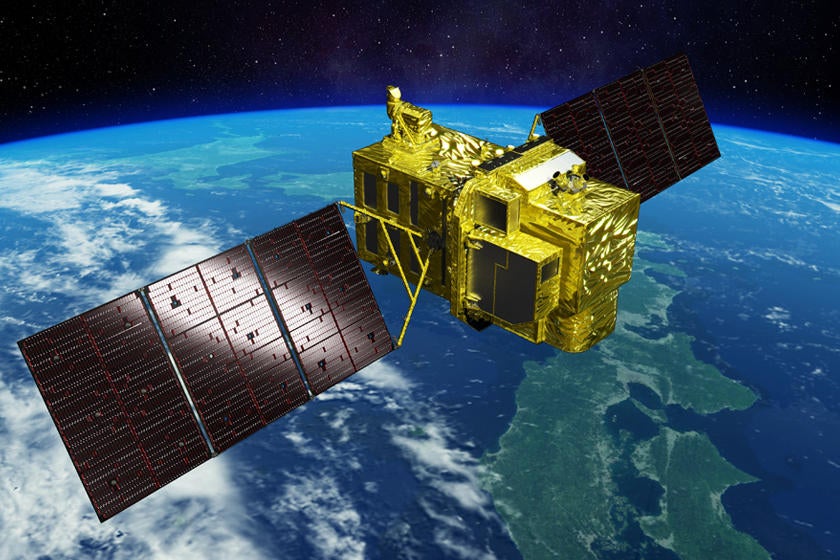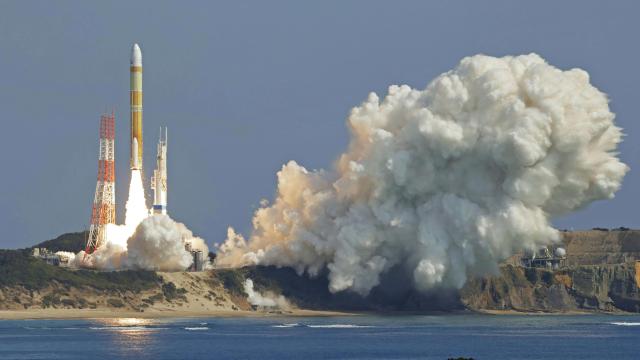Japan’s H3 rocket failed to reach orbit on Monday, so instead of celebrating the debut of a flagship launch vehicle, Japan’s space agency is scrambling to understand what went wrong and what it means for Japanese space policy going forward. There’s also a backlash afoot, with a former astronaut rightly asking why a $US2o0 million satellite was included in the test mission.
The H3 rocket took flight on Tuesday at 12:37 p.m. AEDT, lifting off from the Tanegashima Space Centre in Japan’s Kagoshima Prefecture. Less than 14 minutes later, the H3 upper stage and its payload — the ALOS-3 advanced Earth-observing satellite — were reduced to flaming bits and pieces that rained down onto the Pacific Ocean a few hundred miles off the Philippine coast.
Following successful separation with the booster, the lone second-stage engine failed to ignite, forcing controllers to transmit the dreaded self-destruct command. That the second stage, and not the first stage, was the cause of the failure came as a huge surprise, as the first stage employed the experimental LE-9 engines.
The rocket failed to leave the ground during the first launch attempt on February 17, the result of an electrical glitch. But where the first attempt led to an abort at the pad, the second led to catastrophic failure.
Normally, unflown rockets are packed with dummy payloads. Space is hard, as they say, and no launch provider can guarantee that their rocket will perform as expected on its maiden voyage. In this case, however, the Japan Aerospace Exploration Agency (JAXA) chose to risk it, and in so doing lost a satellite that cost $28.2 billion yen to develop — a price that equates to roughly $AU314 million.

ALOS-3, also known as DAICHI-3, was no toy. The 3-tonne imaging satellite was a vast improvement over its predecessors, with expected imaging resolutions as fine as 2.62 feet (0.8 meters) and a field of view measuring 70 kilometres across. JAXA planned to use ALOS-3 to upgrade global geospatial data, to monitor the Japanese coasts and interior, and — crucially — to track natural disasters.
Earlier this week, retired Japanese astronaut Soichi Noguchi expressed his displeasure about the mishap over Twitter. “I’ve been hit by the H3 rocket failure,” he tweeted (machine translation by Yandex). “What is the necessity of putting [an operational] satellite on a test machine in the first place?” He pointed out that JAXA had used dummy payloads in the past, while advising the space agency to take its investigation slowly so as to not “strike out” next time.
Some government sources are claiming that the second launch attempt was done in haste, with the March 10 end of the launch window looming, The Japan Times reports. As for the decision to include ALOS-3 in the demonstration mission, JAXA “may have had no choice but to mount a real satellite to make up for the delay” in its development, Kazuto Suzuki, an expert in space policy and a professor at the Graduate School of Public Policy at the University of Tokyo, told The Japan Times.
It could be a while — possibly years — before H3 flies again. It’s a staggering possibility, one made all the more frustrating given that Japan had hoped to launch the rocket in 2020. Development delays with the LE-9 engine resulted in the two-year delay.
Monday’s launch failure is sure to throw a serious wrench into Japan’s space policy. The 57-metre rocket, in development since 2013 in partnership with Mitsubishi Heavy Industries, is being positioned as JAXA’s flagship rocket, with an anticipated launch cadence of two per year for the next 20 years. The successor to Japan’s HIIA rocket, it features a simplified first stage, bigger payload capacity, fewer components, and improved flexibility. Cost per launch is estimated at around $US38 ($53) million, making H3 desirable to both the public and private sectors.
JAXA had been planning to use the rocket to launch its Martian Moons eXploration (MMX) next year, in addition to launching supplies to the International Space Station. Plans were also afoot to modify the rocket such that it could transport cargo to the lunar environment and assist with the construction of the upcoming lunar Gateway.
“Unlike the previous cancellation and postponement, this time it was a complete failure,” said Hirotaka Watanabe, a professor at Osaka University. “This will have a serious impact on Japan’s future space policy, space business and technological competitiveness.” https://t.co/MyIpkuAP0P pic.twitter.com/678CBVjHqX
— Tokyotronic (@robotopia) March 7, 2023
“We take this series of launch failures very seriously,” said JAXA president Hiroshi Yamakawa at a news conference on the day of the launch failure. “It is our responsibility to investigate the cause of the failure, and our top priority issue is to quickly restore trust.”
On Wednesday, JAXA said the second-stage engine likely failed to ignite due to a problem in the power system, while cautioning that it’s still investigating, according to The Japan Times. Control equipment aboard the rocket is supposed to transmit an ignition signal to the upper stage engine, and as JAXA suggests, it’s possible that this equipment failed to do its job. Another possibility is that the signal was sent, but for some reason it couldn’t reach the engine. The true cause could be difficult to suss out, especially given that the rocket is now completely destroyed and unrecoverable.
Needless to say, JAXA is already thinking about ways to move forward. “We would like to think about how we can have a successful launch as early as possible, while proceeding with what we can do now,” Masashi Okada, director general of the H3 project team, said at a press briefing, and as quoted by the Asahi Shimbun.
Interestingly, JAXA has already built a second H3 rocket, but it still needs to undergo engine tests. The rocket is slated to launch later this year, which now seems very unlikely.
More: These Upcoming Missions to Deep Space Have Us Stoked About the Future
